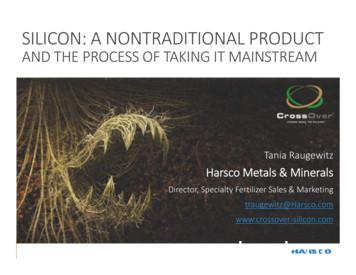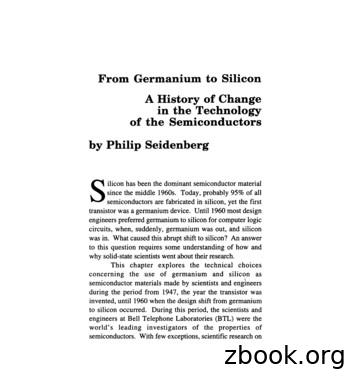SILICON - FIRT
SILICON2nd‘The biochemistry of silicon in planta is a riddlewrappedpp in a mysteryyy inside an enigma.’gEpstein, 2001
What is Soluble Silicon?S l bl SiliconSolubleSili(Mono(Mono(M-SilicicSili i AAcid)id) iis ththe plantplantl tavailable portion of the silica that makes up over40% of soil chemistry. It is generally present inplant tissues in amounts similar to that ofmacronutrientst i t (N(N, PP, KK, CCa, Mg,M S) andd iin somegrasses and grass family crops, often at higherlevels than other macronutrients.In addition: Plants grown in soils with low soluble silicon levelshave a greater susceptibility to disease, drought stressand other plant stresses Silicon has been shown to reduce phosphorus leachingwhile at the same time increasing phosphorus plantavailability. Silicon’s activity in the soil matrix has been proven toimprove micronutrient uptake (boron,(boron copper,copper iron,ironmanganese, zinc) and reduce toxic metal uptake(aluminum) as well as sodium.
Biochemical/genetic role ofsilicon? Silicic acid is absorbed by plants to becontinuously transformed into insoluble polymers Soluble silicon has been detected inside the cell, inthe cytosol,yin chloroplastic membranes as well asin association with RNA and DNA. ThisThi informationi fti suggestst thatth t siliconilican havehaseries of intracellular sites of action to explain itsg propertiesp pin plantpdisease resistancestimulating
Where does soluble Si come from,andd whyh ddo ddeficienciesfi iioccur? In the soil, Silica is generally abundant asmineral quartz and clays, but its abundancein soluble form (mono(mono-silicic acid) is highlyvariable.i bl Continuous cropping of landland, naturalweathering, or inherently deficient soils canbe causes of deficiency. Plants take up silicon into their root andshoot tissue,tissue but it is not returned throughbiodegradation.
AAPFCO News AAPFCO approvalppas a beneficialsubstance: any substance orcompound other than primary,secondary,dandd microiplantl t nutrientst i tthat can be demonstrated byscientific research to be beneficial toone or more species of plants, whenappliedppexogenously.gy
Known Impacts on Plant Health Increases cell wall strength Results in increased wear toleranceDisease resistanceInsect resistanceMore uprightg growthgand rigiditygyIncreased shoot and root density, resultingin higher yieldsRegulates uptake of toxic elementsIncreases heat toleranceSlows transpirationc eases CECC C makingag otherot e nutrientsut e tsIncreasesmore available
Direct Role of Silicon in Plant Health Tissue analysis indicates that silicon makesup between 0.2 and 1010%% of a plants dryweight. ItsIt associationi tiwithith cellll wallll proteinst iindicates an active biochemical function. It is prominent in cell walls as solidamorphous silica, providing a structuralbarrier to pathogens. Studies suggest it is translocated from rootst shoots.toh t
The mechanical barrier hypothesisCuticleCuticle-silica double layer (Yoshida et al., 1962)conidiumcuticleSilica layerOuter cellwallEpidermalEidlcellNo infection in theepidermalidl cellll
Katy (resistant)SiTime (h)01224 3648M201 (susceptible)Si 607296012 2436Si Si-4860 7296012 24 36 48 60 72 9601224 36 48 6072 96PR-1rRNA5. 04. 0RelativeIntensityPR-13. 02. 01. 00. 0012243648607296Time after inoculation ((h))Katy Si-Katy Si M201 Si-M201 Si Source: adapted from Rodrigues et al., 2005
Katy (resistant)SiTime (h)01224 3648M201 (susceptible)Si 607296012243648Si Si607296012 24 36 48 60 72 9601224 36 48 6072 96POXrRNAPeroxidase1. 21. me after inoculation (h)Katy Si-Katy Si M201 Si-M201 Si Source: adapted from Rodrigues et al., 2005
Katy (resistant)SiTime (h)01224 3648M201 (susceptible)Si 607296012 243648Si Si607296012 24 36 48 60 72 9601224 36 48 6072 96GlurRNA2.0E-1,3-glucanase1. 5RelativeIntensity1. 00.50.0012243648607296Time after inoculation (h)Katy Si-Katy Si M201 Si-M201 Si Source: adapted from Rodrigues et al., 2005
HPLC analysis of SF5 from FII of non-inoculated andinoculated plants amended or not with silicon0.6Si-0.4non-inoculated0.6inoculatedSi-46 min040.40.20.20.00.0Momilactone A04045500.6Si ulatedSi 47 minMomilactone B0404550Minutes550404550Minutes55Source: adapted fromRodrigues et al., 2004
ConclusionSi-Si Low levels ofmomilactonesHigher levels ofmomilactonesandHigh level of blast severityzandLow level of blast severity
Influence of silicon on Bipolaris leaf spot in bermudagrass Si% Leaff spot severity-Si120100806040200 Si- SSi12345Days After InoculationSource: adapted from Datnoff and Rutherford, 2004
Conclusions"In Si plants of M201, a differential accumulation oftranscripts from glucanase, peroxidase and PR-1 besides theparticipation of phenolics counteracted the spread of theinvading fungus and the damage that it caused to the leaftissues.
Beneficial Effects of Si on Crop Growth in Relation to Biotic and AbioticStressesAlleviates Excess N StressAlleviatesll iWater StressAlleviatesll iSaltl StressImproves Light InterceptionDecrease TranspirationIncreases Resistance to Biotic StressKeeps Leaves ErectDetoxify MnPrevents LodgingAlleviates Water StressDecreases TranspirationIncreases Strength of StemChanges Mn distributionDDepositioniti on StStemDeposition on LeavesDeposition on HullAlleviates P excess stressShootRootnSiO2SiliSilicanSi(OH)4Silicic acidDecreases P uptakenSiO2SilicaAlleviates P deficiency stressImproves Internal P availabilityDecreased Mn uptakeAlleviates Mn excess stressSoil SolutionnSi(OH)4Silicic acidForms Al-Si ComplexesDetoxify Al
IntroducingI t d iEXCELLERATOR
About Excell Minerals Privately held globalcorp. with newownership since 2003. Headquartered inPittsburgh, PA. Excell Minerals is aworldwide leadingproducer of productsfor the agricultural,metals, turf, andcementt industries.i d t i
EXCELLERATORExcellerator Chemical Analysis:¾¾¾¾¾¾¾¾¾¾¾¾¾¾Silicon Supplement:Supplement: 39.3%CaMgSiO4 - 5.8%Ca3Mg(SiO4)2 - 17.9%Ca2MgSiO7 - 8.0%Ca2SiO4 - 7.6%Micronutrient Package:Package:Calcium (Ca) – 24%Iron (Fe) – 1.8%Copper (Cu) – 0.05%0 05%Boron (B) – 0.02%Magnesium (Mg) – 6%Manganeseg(Mn)() – 0.7%%Zinc (Zn) – 0.05%Molybdenum (Mo) - 0.004%
EXCELLERATORGranular productSGN 100 and 200R dil solubleReadilyl blSilicon, Calcium, and Magnesiumdriven Higher in Silicon (39%) than anyknownococompetitorpet to
What Makes EXCELLERATORUnique? Excellerator’s custom blend ofnutrients enhances any turffertilityy program.p g The high level of soluble siliconin Excellerator is its truly uniqueattribute.attribute
EXCELLERATOR Hydrolyzes in the soil to form monoand polypoly-salicic acids, which is theform the pplant takes upp Available in the soil for 12 months,although the majority is taken up inthe first 6 months
Toxic Elements Mn uptake is not affected, butdistribution is Mn deposits can cause spotting onleaves Si prevents this by distributing itthroughout the plant Sodium toxicity reduced
Improved Nutrient UptakeWinter Wheat Tissue Analysis Silicon Vs. Phosphorus0.370.350 330.33P (% ) Monosilicic acidconcentrationsin some soilshave beenassociated witha 1010--80%80%increase inavailable P andincreased plantP uptake andyield. Reducesphosphorus runoff in sandysoilssoils. Improves CEC0.310.290.270.250.400.500.600.700.80Si (%)Aglime 1Aglime 2Excellerator0.901.00
Effect of Silicon Fertilizer on theRoot ZoneDr. V. MatichenkovMatichenkov——University of Florida Rice And Citrus Studies
Protection Against Temperature ExtremesPhotographg p of creepingp g bentgrassgexposedpto highg temperature.pPlants had been grown for 55 days at 20 qC , and then exposed toa temperature of 35 -40 qC under constant light and humidity for20 days. The growth of creeping bentgrass applied silicon sourceswas similar. However, most of the control plants grown 35 qCabove had died by day 20.Source: adapted from Lijun, et. al. 2004.
Application Recommendations Soil testing shouldbe done StandardSt d d rates:tInitial application of25lb/M on greenstees,tees fairways andsports turf. Follow with 10 lbs.lbstopdressing 30days apart toachieve 50lb/M peryear
Marketing EXCELLERATOR
EXCELLERATOR DiseaseDiresistancei t Reduced chemicalapplications?li ti? Reduced waterneedsd Increased weartolerancet l Saves labor inotherth areasAdded Selling Points
Marketingg EXCELLERATORCO Excellerator is 3939.3%3% soluble Silicon Competition is much lower in siliconcontentt t (33%) Breaks down easier than competitor Available in 50 lb bags and 1000#bulk bagsg Increases nutrient availability whilecutting other fertilizer costs
ResearchThe evaluation of Silicon has been ongoinggg for the ppast 30 years.y Dr. G. Korndörfer, University of Uberlandia, Brazil working onwet-land rice in Florida concluded: In 19 out of 28 field experiments silica had a positive effecton yield. Considering only sites with Si response, average increasedyield was 1007 Kg/ha (932 lbs/A) Dr. Emanuel Epstein, University of California (Davis) haspublished extensively on silica and plant health and has verifiedthat silicon absorbed by plants:· Is deposited in and strengthens cell walls· Results in plants being more resistant to insect attack,disease, and lodging· Increases yields Dr.Dr. Dr. Dr. Dr.J Chen- University of FloridaJames MenziesMenzies- University of Laval, CALawrence Datnoff- University of FloridaWakar Uddin- Penn State University
Questions?
Excellerator is 393% soluble Silicon CO Excellerator is 39.3% soluble Silicon Competition is much lower in silicon cont t (33%)tent (33%) Breaks down easier than competitor Available in 50 lb bags and 1000# bulk bags Increases nutrient availability while cutting other fertilizer costs
growers back from using silicon? Since 1999 when the first silicon in agriculture conference was held: At least five books, Over 60 book chapters, Numerous reviews and 100s of refereed articles published Clearly, the science for silicon is well‐documented and comprehensive
The CMOS Process - photolithography (1) Silicon Wafer Silicon Wafer SiO 2 1μm Silicon Wafer photoresist (a) Bare silicon wafer (b) Grow Oxide layer (c) Spin on photoresist Lecture 3 - 4 The CMOS Process - photolithography (2) Silicon Wafer (d) Expose resist to UV light through a MASK Silicon Wafer (e) Remove unexposed resist Silicon Wafer
Silicon has been the dominant semiconductor material since the middle 1960s. Today, probably 95% ofall semiconductors are fabricated in silicon, yet the first transistor was a germanium device. Until 1960 most design engineers preferred germanium to silicon for computer logic circuits, when, suddenly, germanium was out, and silicon was in. What caused this abrupt shift to silicon? An answer to .
A remind of the basic properties of silicon will be of great importance to understand well the silicon nanocrystals properties. 2 PHYSICAL PROPERTIES OF SILICON Silicon is, on Earth, the most abundant element after oxygen; weestimates that the Earth's surface is composed about 26% of silicon. [10] This
Intel's Silicon Photonics Research Innovating with lowInnovating with low-cost silicon to create new optical devicescost silicon to create new optical devices 1st Continuous Wave Silicon Raman Laser (Feb '05) Hybrid Silicon Laser (Sept. '06) Silicon Modulators 1GHz ( Feb '04) 10 Gb/s (Apr '05) 40 Gb/s (July '07) 8-channel integrated
Silicon MSDS Section 1: Chemical Product and Company Identification P roduct Name: Silicon C atalog Codes: SLS4102, SLS3313 C AS#: 7440-21-3 R TECS: CW0400000 TSCA: TSCA 8(b) inventory: Silicon C I#: Not applicable. S ynonym: C hemical Name: Silicon Chemical Formula: Si Section 2: Composit
silicon. Some of these facilities produce doped silicon in the order of 20-30 tons per year. Even a small 250 kW reactor with an average flux of 2 x 1012 n/cm2/S can be used to produce useful quantities of doped silicon. The irradiation time is long, about 350 hours for a resistivity of 50 ohm-cm. Therefore, silicon irradiation must be a
1) General characters, structure, reproduction and classification of algae (Fritsch) 2) Cyanobacteria : General characters, cell structure their significance as biofertilizers with special reference to Oscillatoria, Nostoc and Anabaena.























